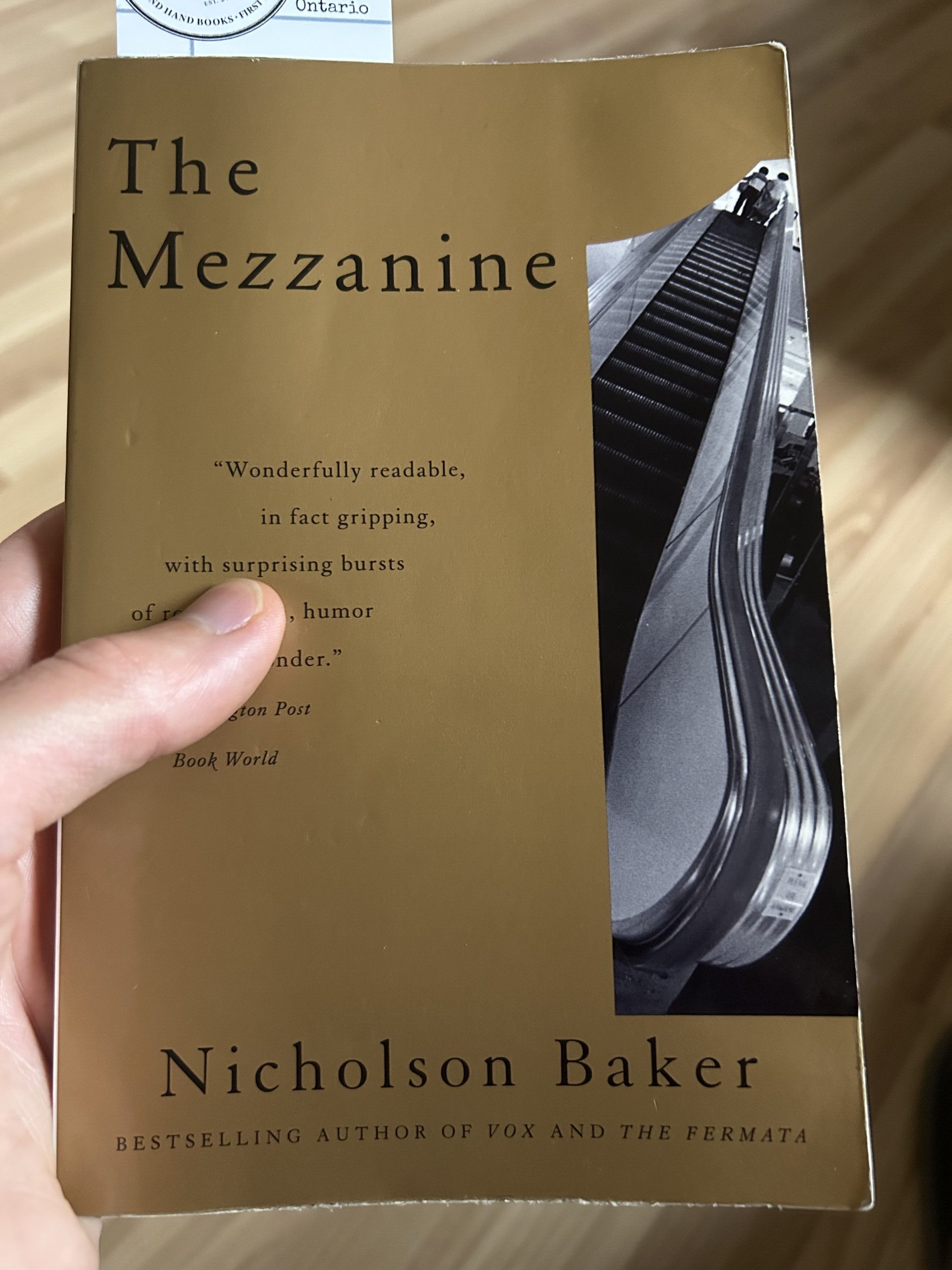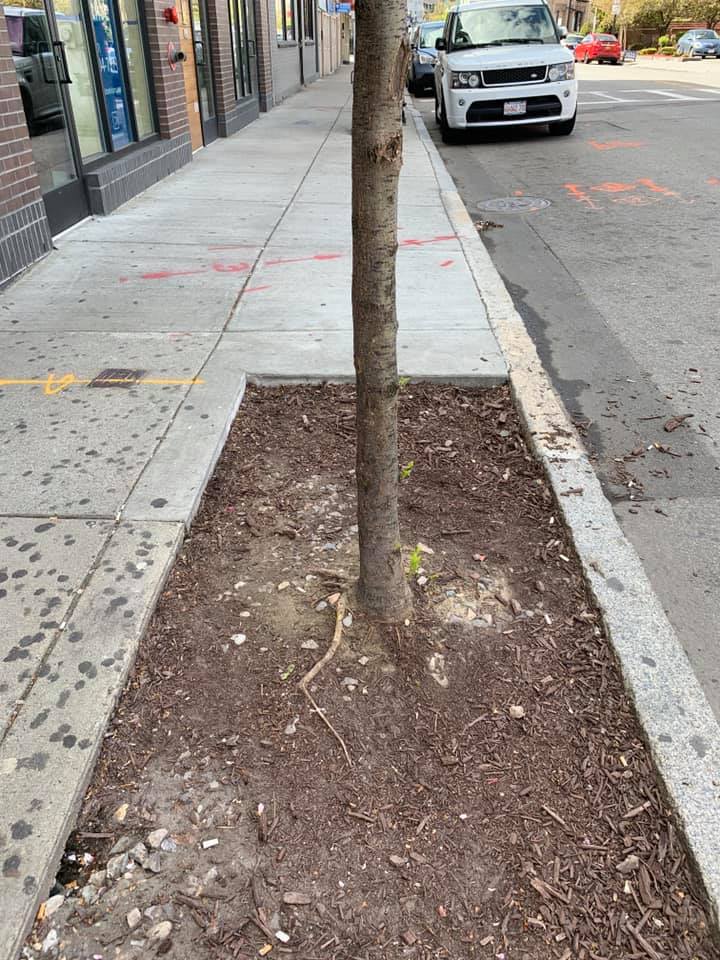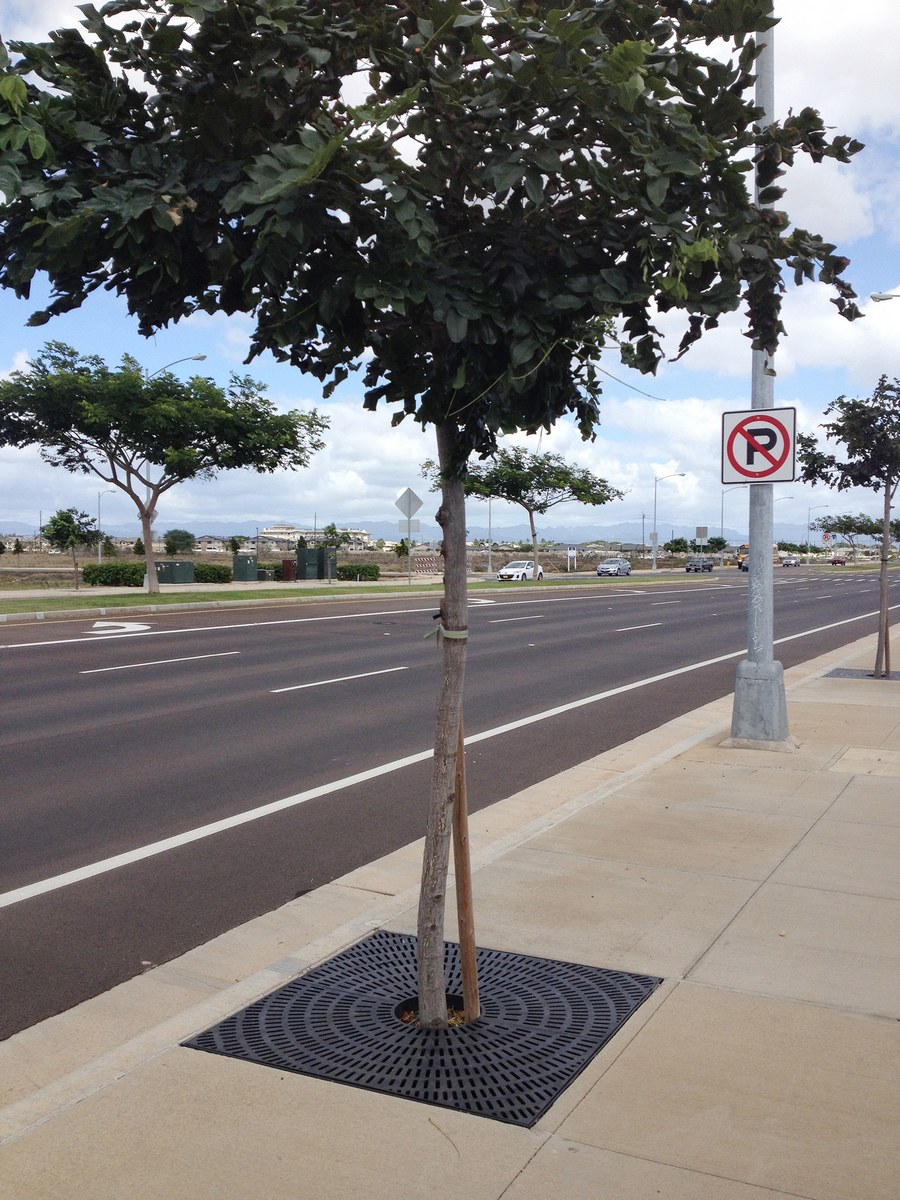by Derek Neal
 Th
Th e Mezzanine by Nicholson Baker is a novel about paying attention. After you read a chapter, you, too, begin paying attention to things you’ve never noticed before.
e Mezzanine by Nicholson Baker is a novel about paying attention. After you read a chapter, you, too, begin paying attention to things you’ve never noticed before.
On my way to work this morning, gliding down quiet, leafy streets in my 2012 Mazda 3 GS-SKY, I noticed a new sign. It was planted in the soil around a tree that had been planted into the sidewalk. In certain cities, this would not have been possible. I’ve noticed that when a tree is planted into the sidewalk, there are three options when it comes to the block of cement that has been replaced by the tree. The most common choice, and the choice that my city has made, is to fill in the square with dirt or mulch.

This was why the sign could be planted there, because there was soft ground in which to insert the two metal rods that held the sign. Another choice is to cover the empty square with a grate. To my mind, this is the sensible choice. If you don’t cover the square, trash and cigarette butts will quickly fill in the square, which will be difficult to remove because you can’t simply sweep them up—the level of the dirt is not flush with the sidewalk, so a sort of divot is created in which trash can collect—instead, a city worker will be forced to pick up the trash with some sort of picking device, or they’ll have to maneuver a dust bin and broom into the square space around the tree, which must be difficult, considering that the dust bin and broom may not fit easily into the square. This is why the grate is the correct choice: it creates a flush seam with the surrounding sidewalk, prevents trash from collecting in the area around the tree, and makes cleaning easier.
Another benefit of the grate is that when you are walking you don’t have to change your stride. Without the grate, you have two choices:
- You can change your route to avoid the dirt around the tree. The issue here is that if you are walking with someone, you will enter into their path and possibly disrupt them, or, if you’re able to, you can place one foot in front of the other, as if on a balance beam, and walk three or four steps in this way, all while maintaining your balance, so that on one side, you don’t bump into your companion, and on the other side, you don’t fall into the area around the tree.

Sidewalk tree with grate You can step into the area around the tree. The issue here, besides the trash, is that the area around the tree is slightly lower than the level of the sidewalk. You expect to hit ground at a certain point—your body seems to know this intuitively—but the ground is not there, and so your foot picks up speed and hits the ground with more force, as when you expect a step to be there at the end of the stairs, but it’s not. Now there’s the possibility for injury. There was a recent topic of controversy in my city that has some connection to this issue of sidewalk trees. It concerned the slope of the sidewalk when it connects to a driveway on one side and a road on the other side. In a suburb, this is not an issue, because in between the sidewalk and road there can be a strip of driveway that slopes to connect the two, but in a city, when this space isn’t available, the sidewalk has to slope to connect the road and driveway, which creates a problem for pedestrians walking on the sidewalk, since they will suddenly be on uneven ground. There are two ways to address this problem:
- The sidewalk slopes at a steady rate from the street to the driveway.
- The sidewalk slopes steeply from the road, then levels out and is flat from the middle of the sidewalk to the driveway.
Choice B is usually considered the correct choice, because although it creates the possibility for a car to scrape its bumper if it enters the driveway too quickly, it also allows for two people to walk on the sidewalk without changing their stride. In the case of option A, if two people are walking then at least one of them will be forced to walk on an uneven slope, with one foot hitting the ground at a lower level than the other foot, much like the case of the dirt area around a tree in a sidewalk square.
Besides the grate and the dirt area, there is also the possibility of filling in the square with cement or asphalt, in which case the tree simply protrudes from the sidewalk. This seems to be a less common option—I haven’t seen it much—and it surely looks good at first, but the issue is that over the years, as the tree grows, the roots will cause the cement to crack and buckle, eventually creating the need to replace at least that square of cement and possibly others as well. These choices, of course, have implications for public safety, the government budget, and more generally, the atmosphere of the city itself and our day-to-day experience. Each individual choice adds up to something greater than itself. As the narrator in The Mezzanine notes, after describing the way plastic straws came to displace paper straws in the 80s, resulting in floating straws that one had to stoop down to drink when using with a soda can: “In this way the quality of life, through nobody’s fault, went down an eighth of a notch…” (5). One could say that choosing the mulch/dirt option rather than the grate option also decreases our quality of life, although I’m not in a position to say how much, being much less skilled in this sort of domain than the narrator of The Mezzanine.
But the sign. The sign, which was for a “fast casual” restaurant called “Pita Pit,” said “GET IN HERE FOR A SMOOTHIE!!” The first thing I registered, when looking at this sign, or rather, when the sign entered my field of vision before quickly disappearing as I glided by in my 2012 Mazda 3 GS-SKY, was that Pita Pit was talking about smoothies. Upon reflection, this makes sense. I wouldn’t have known that Pita Pit offers smoothies if I hadn’t seen this sign. I’ve never patronized Pita Pit on my lunch break, not because I don’t like its offerings—in fact, I do like kebabs, souvlaki, gyros, and shawarma, and I often get one of these wrapped sandwich combinations for my lunch—but because there are simply too many good options in the area surrounding the university where I work to go to a chain like Pita Pit. The next thing I noticed was the use of two exclamation marks. Why two? Why not one? The people at Pita Pit, perhaps thinking that they could connect better to the college students who are their main customers, had apparently opted for two exclamation marks to give their sign a casual feel, a friendly feel, an off the cuff feel—like a text message—rather than the ever so slightly more formal single exclamation mark. However, this choice felt misguided to me, because I am not a customer of Pita Pit, and the sign is seemingly directed at people like me—people who don’t go to Pita Pit and are thus unaware that they offer smoothies—but I don’t feel the closeness with their establishment that would permit the use of two exclamation points. The other issue I have with the sign is the use of the imperative mood, the fact the sign is ordering me to “GET IN HERE.” If the sign were inviting me for a smoothie, perhaps I would consider it, but the brusqueness of “GET IN HERE,” even when accounting for the attempt at a facetious tone, didn’t resonate with me. Needless to say, I have no plans to visit Pita Pit anytime soon.
Normally I would not have given the sign a second thought, but as I said at the beginning of this piece of writing, I’ve been reading The Mezzanine. This novel takes place, as the narrator notes, during “a specific lunch hour several years ago,” although even this is too expansive; the duration of the novel is just more than the time it takes to ride an escalator up one floor, from the ground floor to the mezzanine of an office building. How does one write 135 pages covering a period of less than a minute? One pays attention. In a way, the novel imagines if In Search of Lost Time was just the madeleine scene, the beginning being the dipping of that biscuit into the tea, and the end being when Marcel swallows the spoonful of tea with the dissolved madeleine in it. The few seconds in between, the time it takes Marcel to drink the tea and the madeleine, would contain all of the thoughts, memories, reflections, and plotlines of the novel, and these stories would be nested inside one another, like a Matryoshka doll. Another way to think of The Mezzanine is as an exercise in defamiliarization. Instead of using the technique as a literary device within a larger work of fiction, The Mezzanine asks what it would be like to eliminate plot altogether, creating an entire novel built on drawing the reader’s attention to the familiar, everyday world by making it unfamiliar, strange, and mixed with the narrator’s memory. The novel takes this idea to an extreme point by choosing the most nondescript place possible—an office building at the end of the 1980’s. The topics for attention are likewise banal and ordinary: a carton of milk, a plastic bag, a shoelace, Scotch tape, staplers, office small talk, but the achievement of the novel is to convince us that even in this world there is beauty and meaning, that a stapler, for example, has followed:
the broad stylistic changes we have witnessed in train locomotives and phonograph tonearms, both of which they resemble. The oldest staplers are cast-ironic and upright, like coal-fired locomotives and Edison wax-cylinder players. Then, in mid-century, as locomotive manufacturers discovered the word “streamlined,” and as tonearm designers housed the stylus in aerodynamic ribbed plastic hoods that looked like trains curving around a mountain, the people at Swingline and Bates tagged along, instinctively sensing that staplers were like locomotives in that the two prongs of the staple make contact with a pair of metal hollows, which, like the paired rails under the wheels of the train, forces them to follow a preset path, and that they were like phonograph tonearms in that both machines, roughly the same size, make sharp points of contact with their respective media of informational storage…And then the great era of squareness set in: BART was the ideal for trains, while AR and Bang & Olufsen turntables became angular—no more cream-colored bulbs of plastic! The people at Bates and Swingline again were drawn along, ridding their devices of all softening curvatures and offering black rather than the interestingly textured tan. And now, of course, the high-speed trains of France and Japan have reverted to aerodynamic profiles reminiscent of Popular Science cities-of-the-future covers of the fifties; and soon the stapler will incorporate a toned-down pompadour swoop as well. Sadly, the tonearm’s stylistic progress has slowed, because all the buyers who would appreciate an up-to-date Soviet Realism in the design are buying CD players: its inspirational era is over (14-15).
This is what the novel is—digressions, tangents, memories, anecdotes. When I purchased the novel at a café-cum-bookstore a few days ago, I had a nice chat with the barista who turned out to be a sort of Nicholson Baker aficionado, having read most of his novels and even reread a few. He was excited for me, as The Mezzanine is my first Baker novel, the only reason I picked it up in the first place being that I’d seen it mentioned by the writer Jordan Castro. The barista informed me that Baker’s novels are “without stakes,” and having read the book, I understand what he means, but I also have to disagree with him. The act of paying attention has incredibly high stakes because “if the whole complex lives of many people go on unconsciously, then such lives are as if they have never been” (Tolstoy as cited in Shklovsky). The novel makes you feel this as you read it, the capacity one has for noticing things and thinking about them, and how frequently we lack attention and exist in a state of extended distraction.
After passing the sign, I continued on down the street, still rolling smoothly and at low speed in the 2012 Mazda 3 GS-SKY, before turning left, then left again, and finally coming to rest in my usual spot, on the street next to a local park. I got out of my car and began to cross the park, which is the first part of a walk that I divide into three parts in my head—park, neighbourhood, main street—that I take to arrive at work each day, a walk of 12-15 minutes. Upon entering the park, I noticed another new sign. This one had children playing next to it along with a few adults, which helped to explain the sign, which said, “Early ON,” and then below this, “ON y va.” I was immediately more receptive to this sign than to the Pita Pit sign, and as I continued my walk, I set to work deciphering its meaning. The first thing to know when viewing a public document in Canada is that it is likely to include both English and French. In Ontario, government documents will be in both languages, as will packaging on all items, but other things won’t be, like the Pita Pit sign. Because of the nature of English, which often has adjectives before nouns, compared to French, which often has adjectives after nouns, and because there are so many cognates, sign makers can kill two birds with one stone when complying with these rules by following the order “English adjective, noun, French adjective,” thus avoiding repeating the noun twice. For example, as a kid I went one summer to “Space Camp Spatial,” which is how it was written on t-shirts and  pins, saving space and repetition.
pins, saving space and repetition.
As I exited the park and entered the neighbourhood stretch of my walk, I suspected something similar was at work with “Early ON/ON y va,” yet I was perplexed by the double “ON.” Why repeat the ON? Or was the repetition necessary, this not being a case of noun-adjective-noun but rather a more complex use of the English/French combination particular to Canada? I then realized, focusing on the capitalization of “ON,” that the province of Ontario was being referred to—ON being the abbreviation for Ontario—while also having a second meaning as “on” is a word in both English and French. In French, “on y va” would most likely be translated in this instance as “let’s go.” So we have, in a sense, “Early ON/Let’s go.” As I thought about the sign and its layers of meaning, turning right onto the street that would take me to my office, I became more and more impressed. We had a reference to the province, which had been integrated with a pun in two languages, and rather than a literal translation between English and French, we had two different expressions that had a similar spirit yet somewhat different meanings. To appreciate the full meaning of this sign, I realized, one had to understand both French and English, such that the premise of providing both French and English to accommodate monolingual speakers inadvertently produced a third thing, a French/English combination where the whole was greater than the sum of its parts. Putting it all together, I concluded that this must be some sort of government sponsored daycare program, and when I looked it up upon arriving at my office, I was correct!
Enjoying the content on 3QD? Help keep us going by donating now.
